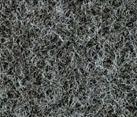 With 13% less cross-sectional area than a standard felting needle, and with its stabilising edge profiles, Groz-Beckert‘s new EcoStar not only requires less penetration strength but also has a longer service life, enabling a more even product surface and improved fibre transportation.
With 13% less cross-sectional area than a standard felting needle, and with its stabilising edge profiles, Groz-Beckert‘s new EcoStar not only requires less penetration strength but also has a longer service life, enabling a more even product surface and improved fibre transportation.
A lower needle cross-section while maintaining stability thanks to its edge profiles, a newly-designed RF barb with an improved grip on the fibre and thus more compact fabric integration and reduced wear all contribute to a product that not only further improves the production process but also has a positive impact on value-added and the eco-balance.
Field tests have proved that in comparison to standard needles, the EcoStar felting needle has far better wearing characteristics – wear and tear on the barb is significantly lower than with a standard product. The smaller needle cross section is also advantageous as a result of its stabilizing edge profiles – its breaking and bending properties are identical to those of a standard felting needle but thanks to lower penetration forces, there is less stress on it during the production process. This adds up to longer needle life overall and also extended performance.
The special shape of the needle – the convex working part core and the three edge profiles evenly staggered around the needle core at 120° intervals – is responsible for reducing the needle cross section by 13%. This means that less penetration force is required during operation, so power consumption is also reduced. A major part in this energy saving is played by the special form of the barbs in the edge profiles, which enable an even tighter looping angle of the fiber at the undercut.
As a result, with high fabric weights the EcoStar enables power cost savings of up to 7% in relation to a standard felting needle. At first glance this may seem only a minor advantage, but overall it can mean up to one kilowatt hour of energy savings per machine. Seen in terms of one calendar year, with 180 workdays and with 85% machine capacity utilization (20 hours, 7 days a week), and at an electricity price of 10 cents per kilowatt hour, this results in savings of €328.
In addition to all these benefits for the production process and value added, the newly developed EcoStar can also contribute to an improvement in product quality as compared to the standard needle. Due to its new edge geometry the RF barb is differently formed, resulting in lower material distortion at the sides of the barb. This results in a tighter looping angle of the fibers: the yarn is gripped better and the felts produced by the EcoStar are more compact.
Further visible advantages are the smaller penetration holes, and also the reduced material displacement during penetration – both enabled by the reduced needle cross-section. This gives the product surface a far more even, high-quality look.
In all areas of application so far tested, standard felting needles have beenreplaced by the EcoStar with minimal setup, and without any negative effects on product properties. Changes to machine parameters are now a thing of the past – extending product ranges is user-friendly and problem-free.